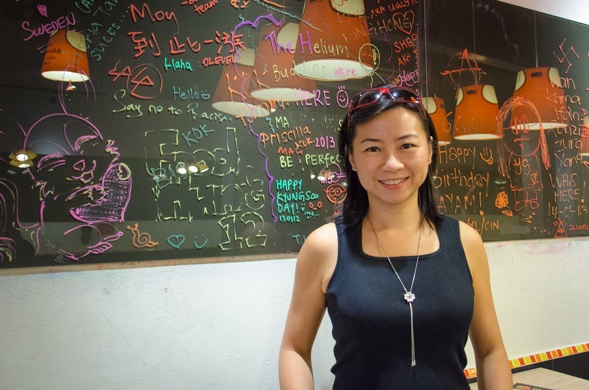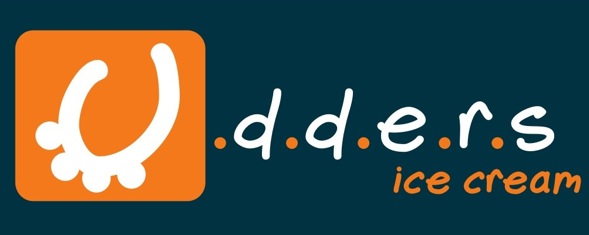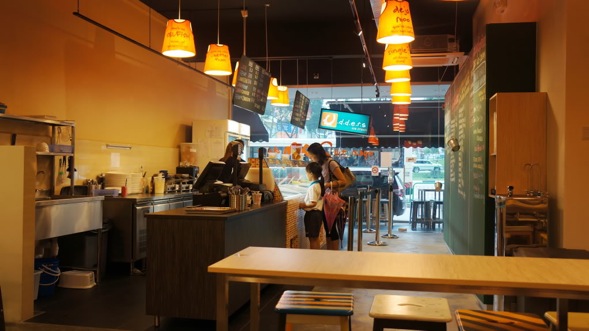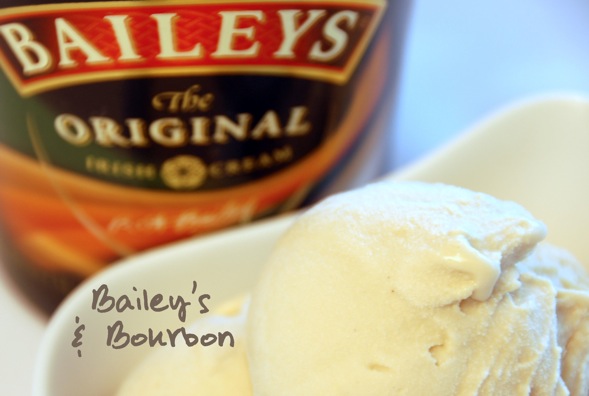Wong Peck Lin is a co-founder of Udders Ice Cream with her husband, David Yim. Started in 2007, Udders is a fun, innovative and energetic ice cream parlour with a cheeky personality. As part of the Udders management team, Peck Lin oversees the brand and business development aspects of the business.
Prior to starting Udders, Peck Lin was a management consultant in the areas of strategy planning, franchising and licensing. She is also a trained lawyer.
The Columnist (TC): Thank you for taking time out of your busy schedule to do this interview. Let’s start off with a question of purpose: What is your approach to ice cream development and design?
Peck Lin (PL): When we set out to conceptualise this business, we wanted the ice-cream to be quite different than what was out there in the market 5 years ago. So, we set out to design the ice cream flavours to set the brand apart from the other dominant and mainly western brands out there.
For example, we designed alcoholic flavours and they are actually quite strong. Three scoops of our Rum & Raisin flavour would be equivalent to a can of beer. That is actually one of the strongest alcoholic ice cream flavours in the market. So the first point is that we set out to specialise in alcoholic ice creams.
The second point is that we also designed the ice cream to have quite a few asian flavours and so quite early on, we developed the Mao Shan Wang durian flavour which quickly became one of our best sellers. We were one of the first to have that flavour and I think it served us well. So that has also set us apart from, say, the international western chains. So having asian flavours and developing them is our second niche in terms of ice cream design.
The third thing is our general ice cream design philosophy. When we set out five years ago, compared to the American-based brands, they tend to be heavier in milk and cream and sugar. As we know, American tastebuds are much more attuned to cream and milk because of their diet whereas for Asians, we take a lot less. In terms of ice-cream philosophy, what we wanted to achieve is an ice-cream flavour for Asians. That meant that our ice cream has much less fat, cream and milk. So we are very clear that we are here to design ice cream for the Asian palate.
TC: So you’re very clear about your design philosophy and your ice cream. But when you first started Udders, was it like that as well? Were you clear about how to build an environment that would engage and excite your customers?
PL: In the beginning, I think we were very clear about the type of concept that we wanted to create and I think at that time, five years ago, quite of the few western brands which we were benchmarking ourselves against (because they were the market leaders) generally had a cooler, cleaner concept. So we wanted to have a concept that was radically different. We wanted it to be a lot more energetic, fun and a lot more fluid. As a result, we thought of having something for the customers to write on.
I think that does a number of things. One, they feel that they are part of the concept, that they are part of the entertainment in the store. Because when they write, other customers that come along after them also get to read and see what was written. So they get to be part of that entertainment in the store. For example when they write a note to their friends, a few days later, they do come back as a group to show their friends what was written. It just brings them back as regulars.
Our objective was also to always get customers to laugh when they come into our store. We looked very hard for quirky, cheeky jokes that go along with our brand of ice cream. You can see some of the quotes on the walls and the lampshades in our stores that really bring out who we are. We’re not very serious, and we certainly don’t take ourselves too seriously and I think our customers shouldn’t either. It creates a fun, relaxed and happy atmosphere.
TC: So you used the design of all the items to bring out the flavour of the brand itself.
PL: Yes. And I think that one thing we have realised is that we are not just selling ice cream, we are selling an experience. Especially for ice cream because it is not something you have to eat. Ice cream is not a sustenance food. It’s really something you eat for fun and in anything that you do for fun, you’ve got to have a fun place to do it in. So our whole environment and ambience is geared towards adding to the fun of having ice cream.
TC: You have a voting board for new flavours as engagement with your customers and use that feedback to guide ice cream design. Could you tell us more about how you came up with the voting for flavours and how you evolved that?
We still have it at our Novena and Siglap branches actually. I think we came up with this idea partially because of David’s background as a teacher. When we came up with using chalkboards for people to write and draw on it, we wanted to further involve the customer in the ongoings of the store. We didn’t want the experience to be transactional. We wanted to give them a say in what was happening to the business.
TC: So, you brought in some form of democracy into the ice-cream making process!
PL: I guess that’s right! (laughs). It is a very light democracy but it did help us get an idea of the tastes of our customers. Especially in Novena and Siglap, there are quite a few expats. So when you see the flavours they write down, for example, some of them could be very Korean-based flavours, you get a sense of the clientele as well. It’s a really good way to generate ideas and when we observe the voting process, it also gives us some idea of which flavours are more mainstream and acceptable. It’s always nice to have some niche flavours among the mainstream flavours!
TC: So what kind of flavours did you adopt from the voting?
PL: We actually combined Snickers bars, Mars bars, honeycomb and vanilla as one flavour. They were actually separate suggestions but when we placed them together, we felt that the taste was right. It’s actually one of our best sellers and the kids love it.
TC: How did customer feedback help you design the ice-cream eating experience better?
PL: Last year, we introduced sundaes. Previously, it was single-scoops, double-scoops, waffles which was very a la carte. But some people want “The Works” and the sundaes fulfill that need because they are made out of combinations that are already pre-determined to be the best. In essence, they go together like wine and cheese.
The taste and texture of the sundaes – in essence the actual ice-cream eating experience – is encapsulated and enhanced by understanding what customers liked and then giving it to them in a package. Everything in the sundae combinations are geared to excite people. The philosophy is a “one plus one equals to three idea” where you get that flavour explosion from all the separate elements coming together.
Additionally, we created alcoholic sundaes that sort of round up the collection and give the range an edge. I would say that the feedback helped us build a viable selection of alcoholic sundaes that appeal to people and really enhance the ice-cream eating experience.
TC: Every retail store has some failures in innovation. Could you tell us how Udders managed to learn from such failures and come out stronger?
PL: There were some flavours that didn’t work. We tried Kimchi ice-cream, especially for our Bukit Timah store, which had a higher number of Korean expats. It was an interesting but after a long time it just didn’t work so we dropped that.
We learnt that sometimes, following the flavours of the community may not be the best way to go about and that there are a confluence of factors.
Firstly, it’s important to know whether this is the flavour that people would like. The second thing is whether we can get the ingredients at all and if these ingredients are good enough to make the flavour. The third thing is even if these two are there, whether we can achieve a high enough standard for the flavour to pass the consumer taste test is another factor. So at any one of these points, we can fail.
TC: How do you imbue a sense of connection, ownership and emotional involvement to make your ice cream compelling?
In order for a connection and ownership to occur, we have to build up our staff to care about the business and the ice-cream. They have to feel a connection and ownership of the company before the customers can feel it.
To start off, we genuinely do care for the them. There is quite a lot of team building we do offline, outside of work. Just last Sunday, we played paintball. We are also going for the OCBC cycling event and some runs. Every month, we also have an activity with them after the staff meeting. For the last two months, we did Zumba and I think we’ll be doing kickboxing later.
This kind of activity is selected because our staff are all 20-plus years old so they are all very active. More importantly, we find that having more of these offline activities help them get to know each other better. It also helps us to relate to them not just as bosses to employees but also as people. This really helps when it comes to a work setting.
We also try to teach them about business. We have business book readings and discussions at staff meetings. We focus on what they think about the book and how it relates to their work. We also make sure they have a point of view and get them to agree or disagree with the information presented to them.
We want to develop them beyond just “doing” and move them towards “thinking about what they are doing” because they are the people on the front line, facing customers everyday. This means that any business innovation is quite likely to come from them. We can think about the big picture but the real nitty-gritty that makes the difference is going to come from them.
For example, we had a particular way of cleaning the oven that one staff suggested. Before we implemented the solution, it was a chore to clean the oven. This new method saved 30% of cleaning time every night. Her suggestion allows everybody to go home earlier. Simple little things like that, if you multiply them by 50 per year, imagine the amount of savings and goodwill generated.
So that’s the real challenge for us: How to engage our staff? It’s all there in their heads sometimes but they don’t say it because of the “why should I? I’m just a worker” mentality. But if you genuinely engage them and they feel like a part of the company, they will respond to you.
TC: How do you see the Udder’s Experience evolving in the future?
PL: Well, we do want to go overseas. I think that would add an interesting dimension to the Udders experience. Even in our neighbouring countries, the taste and style is different. So if we could work with a franchisee to develop the flavours which are local to their own cultures, it would be interesting for Udders as a whole because there is no reason why we cannot swap flavours and introduce them to Singapore as seasonal flavours. So there is a lot of cross-pollination of ideas and tastes, which can only be good for the consumers.
Singaporeans are notoriously sophisticated. We’re travelling to South Africa, Norway, places like that. So, for us in the F&B industry, it’s a lot about really introducing interesting things all the time. So if we had a network of franchisees, we can work with them to continually create new things for customers.
The other thing is that we would like to go into wholesale where we can customise flavours on a B2B level for hotels, airlines, restaurants. I think it would be an interesting addition to the menu of premium places like hotels to have a flavour specific to them. For example, we could create a special alcoholic flavour that can be served only at the airline lounge, presented in a martini glass. That would be something that will impress your business class owners.
We have also gone into a sister brand called the Udder Pancakes. It’s a fun, light branding that goes with ice-cream. This has been doing quite well since we started it two months ago and was wholly created by us, meaning we spent a full year creating the pancake batter, selecting the meats and patties and other ingredients so its all in-house. This is something introduced to compliment the ice-cream so that they can have a full meal here and complete the experience.
TC: So you’re expanding the dining experience from just ice-cream to ice-cream related in this case?
PL: I wouldn’t say ice-cream related but it’s actually a meal experience. In that sense, we are expanding horizontally in terms of providing more than just ice cream but we are also expanding vertically in terms of the wholesale and franchise market so it’s still ice cream but different markets that need ice-cream. So the horizontal expansion is synergistic in the sense that there is some relation between the food and the ice cream.
TC: That’s great! Thank you for the interview and great insights!
This interview was conducted for The Columnist, a newsletter by Consulus that offers ideas on business, design and world affairs. The views expressed in this article are those of the interviewee and do not necessarily reflect the views of Consulus.







